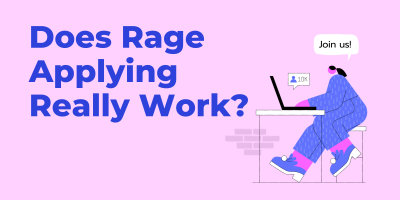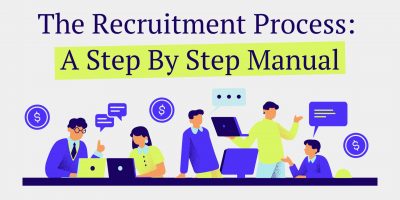
Does Rage Applying Really Work?
Is rage applying just another short-lived TikTok trend or a promising employee strategy for landing a better job?


Founder of ReizeClub

Founder of Springify

My5starreviews

Co-Owner of Signature Home Services

Head of People at PhotoAiD
In today’s hypercompetitive environment and tight labor market, the aftermath of hiring a “bad apple” can bring devastating consequences to an organization. In reality, the actual cost of a bad hire goes far beyond terminating the contract and finding a replacement. Knowing how to mitigate these risks and avoid poor hiring practices becomes crucial for an organization’s success and bottom line.
Hiring and introducing a new member to the company can be one of the most important decisions an HR professional makes. It is why the recruitment process is an arduous and lengthy one, on average taking 33 days to fill a position.
Screening every candidate’s skill, assessing if they are a good culture fit, and conducting in-depth background checks for any potential red flags are all part of the process to ensure a good match. While hiring managers have the help of sophisticated ATS software to help with this process, the hiring decision ultimately falls on them.
But what happens when a candidate with stellar credentials and excellent references becomes an unexpected problem dragging the whole team down?
Although it sounds like a rare scenario, it happens more frequently than one would assume. In fact, only 19% of new hires are considered successful, and nearly half of all newly-hired employees are deemed failures after 18 months.
So, what is considered a “bad hire”?
Some warning signs are poor-quality work, disengagement, lack of communication, difficulty working with other employees, and an overall negative attitude around the office.
Other telltale signals that fall under the bad hire definition are:
So, you might wonder what the cost of a bad hire is?
While it is difficult to quantify the actual cost of a bad hire, typically, several variables determine the magnitude of damage to an organization:
Moreover, the cost of hiring a bad employee can affect a business in numerous ways. Not only are there direct monetary losses – like salary or wages paid and the cost of training replacement, but there are indirect costs too. A company faces damages to its assets, morale, reputation, and productivity in the entire office.
Some key statistics that offer insight into the cost of a bad hire include:

When your company makes an employment offer, they put a lot on the line.
The impact of a single bad hire can cause a ripple effect and leave a trail of harmful effects throughout the organization.
The financial implications and cost of hiring a bad employee can seem endless. Maciej Kubiak, Head of People at PhotoAiD, gave us an example of how much the wrong employee cost their company.
He stated,” In the end, it was around $31,000. This figure includes direct costs such as salary and benefits and indirect costs such as time wasted by good employees interviewing and training the new hire and lost productivity while the position was vacant. In addition to the financial cost, the bad hire also had a negative impact on morale and employee productivity. ”
Another example shared with us by Robin Burrill, Co-Owner of Signature Home Services, states, “Yes, without a doubt, we have made bad hires that cost us big time in dollars and in team morale.”
They further explain, “The upfront cost can be broken down in clear terms. There’s the base compensation, medical insurance (if they make it far enough to be eligible), paid holidays that overlap with their time with us (and their birthday paid, too), then company matching for their SIRA plus any company vehicle, cell phone, tablet and uniforms issued.
The actual cost for our employees year-to-year can range from 150-170% of their base pay with all the benefits we offer.”
Most business leaders accept that there is a learning curve in every job, and it will take time to learn the ropes. Employers may allocate additional training or resources to help the employee decrease the ramp-up time.
However, the existing workers will have to pick up the slack, which increases their workload, leading to increased stress and lost productivity in the workplace.
In addition, a new employee with a bad attitude may harass or bully coworkers, affecting their well-being, company culture, and the employee experience of everyone in the organization.
Maciej Kubiak shared one such experience. They commented, “Yes, I have definitely had a bad experience with an employee who disrupted the workplace harmony. It was incredibly frustrating and really detrimentally affected my work performance.
This person would constantly argue with other employees, be very passive-aggressive, and generally just make the work environment feel very tense and negative. It was exhausting trying to deal with this person daily, and eventually, I just had to go to speak to my CEO and file a formal complaint to get them removed from the company.
It was unfortunate, but it was definitely necessary in order to maintain a positive work environment.”
Once a bad employee is notified of their termination, there may be a lot of time theft or lack of productivity in the weeks leading up to their termination.
A bad hire can directly affect the motivation and performance of other employees or a team. Typically, coworkers or team members may be reluctant to work with a bad hire, making it difficult for teams to meet their goals.
Marty Spargo, Founder of ReizeClub, shared an insightful story of how one bad employee can affect the company, “I once hired an employee who was incredibly good at his job. No doubt, his skills were beyond amazing, especially for his age. However, he also had this attitude that was beyond horrible.
The team under him would file complaints against him, saying that he had severe anger issues, unprofessional, and would sometimes verbally harass a co-employee. Hiring him was indeed a gift at first, but when some of my most valued and competitive employees under him left the company because of him, I realized that hiring him was one of my worst decisions for the company.”
Companies spend considerable time and resources building their brand through marketing, P.R. efforts, and assuring good quality service. Yet, all it takes is a single employee to tarnish your reputation and cause irreparable damage.
For example, nowadays, job seekers look at company ratings and employee feedback sites. If potential candidates come across a review from an employee that left on a sour note, it may deter them from applying to your company.
From my5starreviews, Karl Schwantes highlighted the importance of a good online reputation by stating, “Companies with a bad online reputation can cost at least 10% more to hire a new employee. On average, it costs businesses a significant amount of money to make up for a bad reputation: close to $5,000 per hire, according to Harvard Business Review. Having employees leave reviews about your business that are true and accurate can also lead to attracting a higher caliber employee.”
They added that,

When you hire the wrong employee, not only do you lose money that was spent on recruiting, onboarding, and training them, but you have to spend extra money to find a replacement. All the effort and time a hiring manager spends trying to fill a position eventually results in lost revenue.
Robin Burrill shed light on the recruitment costs of a bad hire by commenting, “Of course, the training and onboarding are what makes the biggest hit in dollars and on the team when we have a bad hire. Just making that hire and training them for a month ultimately costs us around 25% of the total annual cost for that employee’s role.
The team members who train the new hire lose massive productivity over two weeks. We start with 100% shadowing time the first week, then taper to 75%, 50%, and 25%. In total, that’s about two and a half weeks lost for any employees training the new hire over the first month.
There’s also the opportunity cost of making that hire and turning down other candidates. In this job market, those candidates quickly find other job offers.”
A bad hire may engage in illegal or negligent activity, leading to legal action. Occupational fraud is estimated to cost American businesses $652 billion each year. The costs relating to legal action may add up considering all the legal fees, settlements, and productivity losses incurred.
While fraud, theft, or embezzlement seem unlikely to happen – the wrong employee may damage your company in other ways. Abuse of sensitive information, committing cybercrime, or sharing confidential data and trade secrets, to name a few, happen very frequently.

Some recruiters may feel pressured to fill roles quickly as the recent Great Resignation caused significant labor shortages in many industries. Finding top talent is even more challenging in these conditions.
However, don’t sacrifice quality for speed.
Implement a rigorous selection process because, as shown above, one ill-placed employee can bring many damaging and costly consequences. With the advancements in AI hiring, there is a plethora of free ATS software available that enables faster and better recruiting.
Other red flags that can help spot a lousy employee from the get-go are:
These red flags should not be ignored.
Many hiring managers falsely believe they can address or correct these behaviors once the employee is hired.
The reality is that it is impossible to hire the right person all the time.
Eventually, even the most seasoned HR professionals will make a bad hire. Hiring the wrong person increases for businesses with a high turnover rate.
Gus Melo, the owner of Springify, shared, “As a cleaning business owner, I have countless stories about bad hire cases, considering the high turnover of staff. It is common in our industry to spend months training new staff, only to have them quit for another job in another industry.”
What are the next steps if you find yourself in a situation with a bad employee?
Here are some specific actions to solve the problem.
Every HR team, manager, and organization has likely had experience hiring a person that wasn’t a good fit. However, it is crucial to understand the true cost of a bad hire as it can lead to thousands of dollars in losses. While there is no one formula, you can avoid making a job offer to the wrong people by conducting a rigorous and consistent hiring process.
Browse our curated list of vendors to find the best solution for your needs.
Subscribe to our newsletter for the latest trends, expert tips, and workplace insights!

Is rage applying just another short-lived TikTok trend or a promising employee strategy for landing a better job?

Uncover the true potential of ATS and CMS in revolutionizing your recruitment efforts.
Uncover the relationship between talent acquisition and applicant tracking systems (ATS), gaining insight into how these components can streamline your recruitment efforts.

Unlock the secrets to a seamless and successful hiring process, empowering your organization to build a dynamic and thriving team.
Used by most of the top employee benefits consultants in the US, Shortlister is where you can find, research and select HR and benefits vendors for your clients.
Shortlister helps you reach your ideal prospects. Claim your free account to control your message and receive employer, consultant and health plan leads.